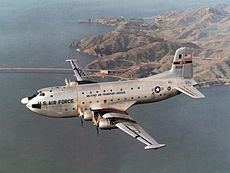Crew 7 Survivors 0 Number of deaths 129 Survivor 0 | Passengers 122 Fatalities 129 Date 18 June 1953 Location Tachikawa | |
 | ||
Similar National Airlines Flight 470, USMC R4Q NROTC c, 1952 Moses Lake C‑1, 1953 Nutts Corner BEA Vick, 1952 Mount Gannett | ||
The Tachikawa air disaster (立川基地グローブマスター機墜落事故, tachikawakichigurobumasutakitsuitakujiko) occurred on the afternoon of Thursday, June 18, 1953 when a United States Air Force (USAF) Douglas C-124 Globemaster II aircraft crashed three minutes after takeoff from Tachikawa, Japan, killing all 129 people on board. At the time, the crash was tied for the deadliest in aviation history, and is notable for being the second aviation accident to kill more than 100 people; the crash of a Luftwaffe Me-321 Gigant glider and its three Bf-110 tow planes during operational trials in 1941 also resulted in 129 fatalities.
Contents
Aircraft and occupants
The aircraft was a USAF Douglas C-124A-DL Globemaster II of the 374th Troop Carrier Group, serial number 51-0137. It was powered by four Pratt & Whitney R-4360-20WA engines.
The aircraft carried 122 passengers and 7 crewmembers. Most of those aboard were airmen who were returning to their duties in South Korea after a five-day rest and recreation leave in Japan. The commander of the aircraft, Major Herbert G. Voruz Jr., 37, had logged more than 6,000 flying hours. The pilot, Major Robert D. McCorkle, was experienced. Another pilot, Major Paul E. Kennedy, was on board to log flying time.
Accident
The aircraft departed Tachikawa Air Base for Seoul at 16:31 JST. Just one minute into the flight, the aircraft's No. 1 (outer left) engine burst into flames. Voruz shut down the engine and called that he was returning to Tachikawa. ATC asked if he wanted a ground-controlled approach (GCA), which Voruz accepted; during this, he could be heard shouting "Give me more power! Give me more power!" to the flight engineer. Ground control asked if he could maintain altitude; Voruz replied "Roger". However, as the pilots prepared to return to the airfield, the left wing stalled, causing the aircraft to roll to the left and enter a shallow, but unrecoverable, dive. In desperation, the pilots attempted to pull up, but in vain. Ground control asked if they were declaring emergency, but received no reply. At around 16:33, the flight disappeared from radar screens. At 16:34, the C-124 crashed into a watermelon patch about 3.5 miles from the airbase and exploded on impact.
Sergeant Frank J. Palyn, 434th ECB, who witnessed the crash from his car, said:
...At this instant she seemed to hit an air pocket because she dropped. After this drop of several hundred feet she went into a left hand spiral dive. [...] At first I thought the plane would make a rough belly landing. The airplane's unusual path of flight seemed to be due to the power being furnished by the right two engines. They seemed to be pulling the plane around and dragging the left wing behind at an angle causing the spiral prior to the crash. The plane itself seemed to head towards the ground at this angle and the left wing, nose approaching the ground first with the tail at an angle to the right and above. [...] Immediately upon contact with the ground she seemed to explode and burn.
The two starboard engines reportedly kept running for some time after the crash.
Emergency responses
Air base and local fire department crews were soon on the scene, followed by chaplains and identification teams. A temporary morgue was set up as victims were retrieved from the wreckage.
USAF Staff Sergeant Robert D. Vess, who was driving from Tokyo with his wife, was about 150 metres (160 yd) away when he saw the aircraft lose control and crash. Vess immediately pulled over and ran to the crash site. Vess pulled the aircraft's radio operator, John H. Jordan Jr., from the wreckage, but Jordan died a few minutes later. Vess then continued to help search for survivors until the aircraft's fuel tanks exploded.
At 16:50, Tachikawa GCA called the 36th Air Rescue Squadron at Johnson Air Base to the crash site. Lt. Colonel Theodore P. Tatum Jr., his co-pilot, and a two-man pararescue team arrived on the scene via helicopter at 17:13; their subsequent inspection confirmed that there were no survivors.
Aftermath
According to the accident report, the crash was caused by the pilots' improper flap usage and airspeed loss due to the failure of a port engine.
The 129-person death toll remained the highest aviation fatality count until 1960, when 134 died in the collision of a United Airlines Douglas DC-8 and a Trans World Airlines Lockheed L-1049 Super Constellation over New York City. The Tachikawa crash remained the deadliest air disaster involving a single aircraft until an Air France Boeing 707 crashed during takeoff in 1962.
There were no fatalities among people on the ground, but one man in the watermelon patch sustained burns to his head and hands.
Although the disaster would largely be forgotten over time, it had a great impact on families of the victims and the USAF.
Local residents erected a monument memorializing victims of the tragedy. However, the monument is no longer to be found at the site, which is now a driving school.
